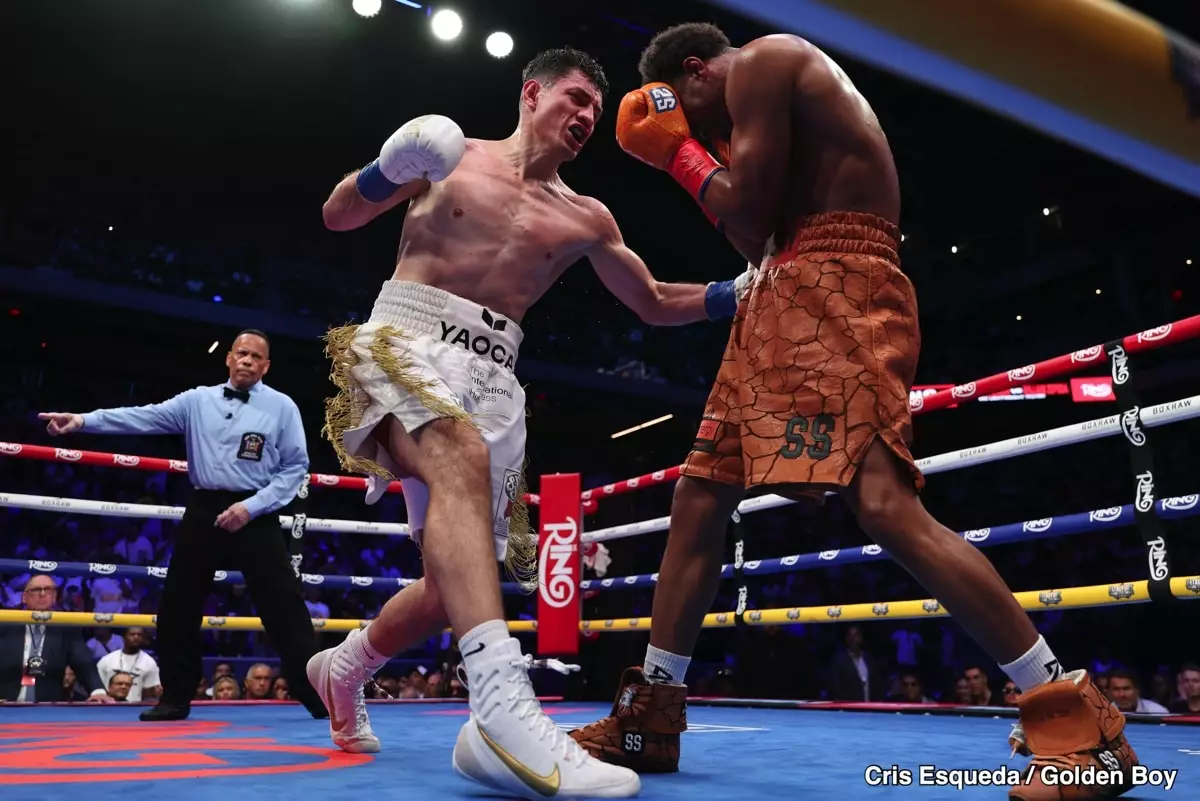In a night filled with fierce competition and dramatic finishes, Hamzah Sheeraz proved decisively that he is destined for greatness within the super middleweight division. His commanding victory over Edgar Berlanga, a fighter known for his power and aggressive style, marked a significant milestone. Sheeraz displayed an admirable mix of resilience and technical acuity, overcoming an early shaky start to deliver a knockout that left spectators in awe.
What stands out most about Sheeraz’s triumph isn’t solely the knockout but his ability to capitalize on moments of vulnerability. The pivotal fourth round showcased his lightning-fast combinations, where a well-timed four-punch blitz ended with two devastating knockdowns. This tactic underscores Sheeraz’s growth—he no longer relies solely on raw power but has integrated precision timing and strategic aggression. His declaration of challenging Canelo Alvarez signals not just confidence but a hunger to carve his name into boxing history.
Despite struggles at the outset, Sheeraz’s psychological resilience shone through as he maintained poise. The ability to adapt swiftly under pressure distinguishes true champions from pretenders. His aggressive pursuit to finish Berlanga in the fifth round encapsulates this newfound confidence, and the decisive stoppage at 17 seconds into the round confirms his readiness for higher-tier challenges.
Judging Controversies and the Quest for Fairness in Boxing
While Sheeraz’s performance was a highlight, the undercard bouts exposed deeper issues within the sport—particularly the inconsistent and often questionable judging. Shakur Stevenson’s victory over William Zepeda, although clear to many observers, was mired in controversy. Judging brackets of 118-110 and 119-109 in favor of Stevenson seemed skewed, especially considering Zepeda’s active and aggressive approach throughout the fight.
This discrepancy illuminates a broader problem: the perception that judges are sometimes influenced by favoritism or home-crowd bias, which can distort the outcomes and undermine the sport’s integrity. Such perceptions threaten to erode public trust, deterring new fans and leaving current supporters disillusioned. The boxing community must urgently address this issue by adopting more transparent and standardized judging methods, perhaps integrating technological aids or independent oversight.
Meanwhile, Subriel Matias’s grinding majority decision over Alberto Puello was another example of subjective scoring and questionable officiating—Puello’s excessive holding was seemingly overlooked, yet it affected the fight’s flow and audience perception. The crowd’s boos reflected their disagreement with the scoring, emphasizing the need for strict enforcement of rules and fair officiating to preserve the sport’s credibility. Judging should reward skill and aggression, not favoritism or leniency towards excessive fouling.
The New Breed of Fighters: Durability, Pressure, and Ascension
The undercard bouts revealed more than just individual talent; they shed light on the evolving character of boxing’s emerging stars. David Morrell’s gritty comeback after being knocked down illustrated resilience—a trait that separates promising fighters from champions. Despite the knockdown in the fifth round, Morrell’s tenacity allowed him to rally, ultimately securing a close victory. His ability to handle adversity and still maintain focus is a promising trait that will serve him well on the path to superstardom.
Similarly, Reito Tsutsumi demonstrated the ruthless efficiency of youth and precision, dismantling Michael Ruiz with relentless body shots and finishing with a clean knockout. At just 22, Tsutsumi showcases an aggressive yet calculated approach, positioning himself as a formidable contender in the featherweight division. His willingness to stalk, attack the body, and finish decisively hints at a promising future, provided he continues to refine his skills and defense.
The diverse styles and outcomes of these contests underscore an important point: boxing is undergoing a transformation driven by fighters capable of enduring hardship, executing strategy under pressure, and seizing opportunities swiftly. The fighters who can combine resilience with skill will dominate the sport’s landscape in the coming years.
The Future of Boxing: Talk of Historic Clashes and Global Destinies
Amidst the action, fighters like Sheeraz and Morrell are already contemplating their next big challenges, hinting at a vibrant future filled with marquee matchups. Sheeraz’s bold claim about facing Canelo Alvarez exemplifies this ambition—he’s not content to simply win fights but aspires to become part of boxing’s elite pantheon.
The upcoming defense of Subriel Matias’s WBC light welterweight title in Riyadh signals a global shift, with champions eager to test their limits across international venues. The sport’s expansion beyond traditional hotspots offers more exposure for up-and-coming fighters, ensuring a more competitive and diverse landscape. These developments promise excitement for fans and heightened stakes for fighters, fueling their desire to leave a lasting legacy.
In sum, this night was more than just a series of fights; it was a vivid illustration of boxing’s resilience, evolving toughness, and the unyielding pursuit of greatness. Fighters are not only battling opponents but also fighting to redefine what it means to be elite in a sport that continuously demands excellence.


Leave a Reply